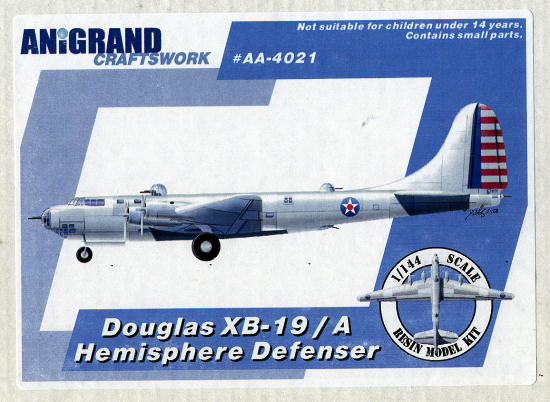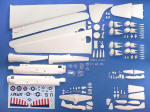
Anigrand 1/144 XB-19 'Hemisphere Defender'
| KIT #: | AA-4021 |
| PRICE: | $136.00 MSRP from www.nostalgicplastic.com |
| DECALS: | Two options |
| REVIEWER: | Scott Van Aken |
| NOTES: | Resin kit. Price includes US/Canadian shipping. Includes XP-60C, XP-57, and XP-59A kits |

| HISTORY |
In 1935, the USAAC launched a top secret project for a super long-range "Project-D" bomber. The Army issued contracts for preliminary design to two aircraft companies, which were designated as Douglas XBLR-2 and Sikorsky XBLR-3. In 1936, the mockups of two designs were inspected. The Douglas proposal was chosen, and the Sikorsky contract was cancelled. As the designation BLR (Bomber, Long Range) was abolished, the XBLR-2 was redesignated XB-19. The progress of the prototype was slow due to the shortage of funds from the USAAC. The Douglas recommended cancelling the project. In 1940, the Army removed the XB-19 from secret project list and announced it to the public that it was a new bomber for American defense. The XB-19 was finally completed and made its first flight in 1941. After the Pearl harbor attack, the XB-19 was painted in camouflage and moved to Wright field for avoiding any Japanese raid. Due to engine problems with the Wright radials (they not only were underpowered but suffered from overheating), the XB-19 was modified with four Allison engines, and was redesignated XB-19A. It began carrying cargo during war time. By the end of war, further development of XB-19 was deemed uneconomical and it was scrapped in 1949. About the only item left of this gigantic aircraft is one of the huge main wheels and tire.
| THE KIT |
 Truth
is that 1/144 is a much better scale for large aircraft than just about any
other. This provides a good size model and yet isn't something that overwhelms
the available display space. Such is the case with a large plane like the XB-19.
To my knowledge, this is the first time this has been kitted outside, perhaps a
vacuform kit, and to Anigrand's credit, they have supplied the alternate engines
this airplane used during most of its flying life.
Truth
is that 1/144 is a much better scale for large aircraft than just about any
other. This provides a good size model and yet isn't something that overwhelms
the available display space. Such is the case with a large plane like the XB-19.
To my knowledge, this is the first time this has been kitted outside, perhaps a
vacuform kit, and to Anigrand's credit, they have supplied the alternate engines
this airplane used during most of its flying life.
klThe fuselage is divided into a fore and aft section with a solid interlock feature that worked so well with their XF-12 'Rainbow' kit and several other larger aircraft. It makes for a very sturdy structure. There are structural reinforcements in the fuselage halves as well. The wings are upper and lower halves and in spite of their length, my samples had no warping at all. Most of the larger castings show air bubbles to some degree. These are generally in the tips of the fin, horizontal stabilizers and wings. I also found a number of pinholes alongside the engraved detail on the fuselage parts. The fuselage also has a few areas where there are small blobs of resin. These are easily sanded off.
None of these will be difficult to repair and anyone who has done Anigrand kits or those from other makers will have run into these and know how to fix them. It is a bit time consuming but not at all hard to do. The large ones can be dealt with using superglue followed by accelerator and then sanding before the superglue fully cures. Smaller ones can be filled with paint or Mr Surfacer 1000/500 then gently sanded. If you have read the XP-60 article, then you will see that this can be easily fixed. A set of clear bits are provided for the cockpit area and for the turrets and tail gunner's position. The clear resin is well molded and while a bit thicker than injected plastic, can be cleared up even more after installation by coating them with gloss clear paint.
In line with other Anigrand 1/144 kits, there are three additional kits of other aircraft. In this case, there is a Curtiss XP-60C, Tucker XP-57 (this was a plane that never made it beyond the 'paper' design, and a Bell XP-59A, America's first jet. The instructions are a set of nicely done and easy to read photo-representations showing where all the bits are to fit. A couple of detail drawings are also included. Differences between the XB-19 and XB-19A (basically engines and props) are provided for. Decals are well printed and should provide no problems. Those that are into bare metal finishes and red/white/blue rudder stripes will want to do the XB-19 while those who like their planes camouflaged will prefer the XB-19A.
| CONCLUSIONS |
One really has to thank Anigrand for doing such a great job of filling in so many gaps in aviation history. This is a prime example of what short run resin can provide for us. Sure, it will take effort to complete, but the result will be a unique aircraft to add to the collection.
| REFERENCES |
Kit instructions
December 2008
My thanks to www.NostalgicPlastic.com for
the review kit. Get yours today and pay no shipping fees in the US or Canada. If you would like your product reviewed fairly and quickly , please
contact
me or see other details in the
Note to
Contributors.